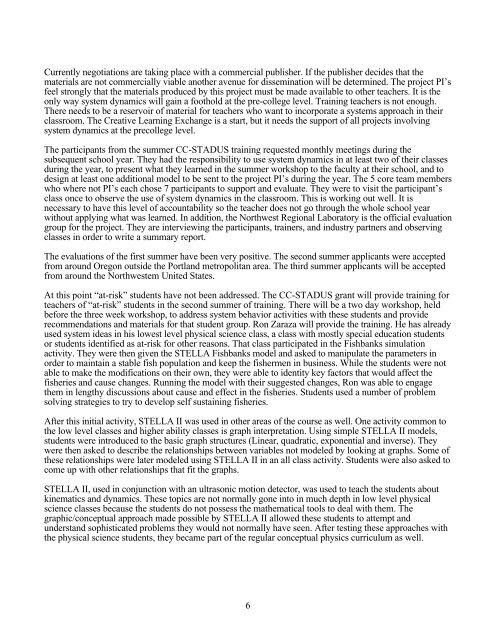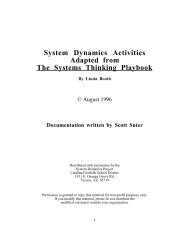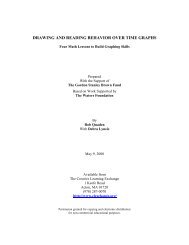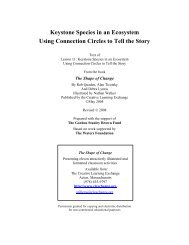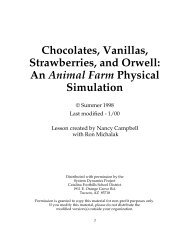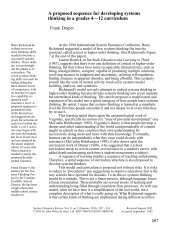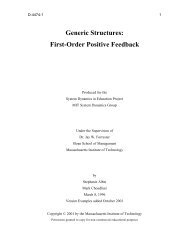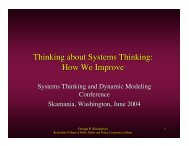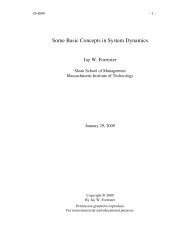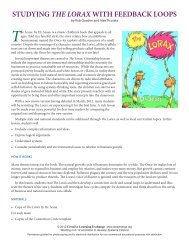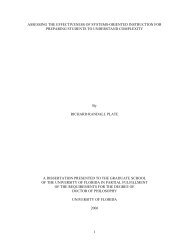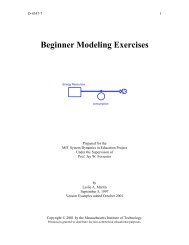Currently negotiations are tak<strong>in</strong>g place with a commercial publisher. If the publisher decides that thematerials are not commercially viable another avenue for dissem<strong>in</strong>ation will be determ<strong>in</strong>ed. The project PI’sfeel strongly that the materials produced by this project must be made available <strong>to</strong> other teachers. It is theonly way system dynamics will ga<strong>in</strong> a foothold at the pre-college level. Tra<strong>in</strong><strong>in</strong>g teachers is not enough.There needs <strong>to</strong> be a reservoir of material for teachers who want <strong>to</strong> <strong>in</strong>corporate a systems approach <strong>in</strong> theirclassroom. The Creative Learn<strong>in</strong>g Exchange is a start, but it needs the support of all projects <strong>in</strong>volv<strong>in</strong>gsystem dynamics at the precollege level.The participants from the summer CC-STADUS tra<strong>in</strong><strong>in</strong>g requested monthly meet<strong>in</strong>gs dur<strong>in</strong>g thesubsequent school year. They had the responsibility <strong>to</strong> use system dynamics <strong>in</strong> at least two of their classesdur<strong>in</strong>g the year, <strong>to</strong> present what they learned <strong>in</strong> the summer workshop <strong>to</strong> the faculty at their school, <strong>and</strong> <strong>to</strong>design at least one additional model <strong>to</strong> be sent <strong>to</strong> the project PI’s dur<strong>in</strong>g the year. The 5 core team memberswho where not PI’s each chose 7 participants <strong>to</strong> support <strong>and</strong> evaluate. They were <strong>to</strong> visit the participant’sclass once <strong>to</strong> observe the use of system dynamics <strong>in</strong> the classroom. This is work<strong>in</strong>g out well. It isnecessary <strong>to</strong> have this level of accountability so the teacher does not go through the whole school yearwithout apply<strong>in</strong>g what was learned. In addition, the Northwest Regional Labora<strong>to</strong>ry is the official evaluationgroup for the project. They are <strong>in</strong>terview<strong>in</strong>g the participants, tra<strong>in</strong>ers, <strong>and</strong> <strong>in</strong>dustry partners <strong>and</strong> observ<strong>in</strong>gclasses <strong>in</strong> order <strong>to</strong> write a summary report.The evaluations of the first summer have been very positive. The second summer applicants were acceptedfrom around Oregon outside the Portl<strong>and</strong> metropolitan area. The third summer applicants will be acceptedfrom around the Northwestem United States.At this po<strong>in</strong>t “at-risk” students have not been addressed. The CC-STADUS grant will provide tra<strong>in</strong><strong>in</strong>g forteachers of “at-risk” students <strong>in</strong> the second summer of tra<strong>in</strong><strong>in</strong>g. There will be a two day workshop, heldbefore the three week workshop, <strong>to</strong> address system behavior activities with these students <strong>and</strong> providerecommendations <strong>and</strong> materials for that student group. Ron Zaraza will provide the tra<strong>in</strong><strong>in</strong>g. He has alreadyused system ideas <strong>in</strong> his lowest level physical science class, a class with mostly special education studentsor students identified as at-risk for other reasons. That class participated <strong>in</strong> the Fishbanks simulationactivity. They were then given the STELLA Fishbanks model <strong>and</strong> asked <strong>to</strong> manipulate the parameters <strong>in</strong>order <strong>to</strong> ma<strong>in</strong>ta<strong>in</strong> a stable fish population <strong>and</strong> keep the fishermen <strong>in</strong> bus<strong>in</strong>ess. While the students were notable <strong>to</strong> make the modifications on their own, they were able <strong>to</strong> identity key fac<strong>to</strong>rs that would affect thefisheries <strong>and</strong> cause changes. Runn<strong>in</strong>g the model with their suggested changes, Ron was able <strong>to</strong> engagethem <strong>in</strong> lengthy discussions about cause <strong>and</strong> effect <strong>in</strong> the fisheries. <strong>Students</strong> used a number of problemsolv<strong>in</strong>g strategies <strong>to</strong> try <strong>to</strong> develop self susta<strong>in</strong><strong>in</strong>g fisheries.After this <strong>in</strong>itial activity, STELLA II was used <strong>in</strong> other areas of the course as well. One activity common <strong>to</strong>the low level classes <strong>and</strong> higher ability classes is graph <strong>in</strong>terpretation. Us<strong>in</strong>g simple STELLA II models,students were <strong>in</strong>troduced <strong>to</strong> the basic graph structures (L<strong>in</strong>ear, quadratic, exponential <strong>and</strong> <strong>in</strong>verse). Theywere then asked <strong>to</strong> describe the relationships between variables not modeled by look<strong>in</strong>g at graphs. Some ofthese relationships were later modeled us<strong>in</strong>g STELLA II <strong>in</strong> an all class activity. <strong>Students</strong> were also asked <strong>to</strong>come up with other relationships that fit the graphs.STELLA II, used <strong>in</strong> conjunction with an ultrasonic motion detec<strong>to</strong>r, was used <strong>to</strong> teach the students aboutk<strong>in</strong>ematics <strong>and</strong> dynamics. These <strong>to</strong>pics are not normally gone <strong>in</strong><strong>to</strong> <strong>in</strong> much depth <strong>in</strong> low level physicalscience classes because the students do not possess the mathematical <strong>to</strong>ols <strong>to</strong> deal with them. Thegraphic/conceptual approach made possible by STELLA II allowed these students <strong>to</strong> attempt <strong>and</strong>underst<strong>and</strong> sophisticated problems they would not normally have seen. After test<strong>in</strong>g these approaches withthe physical science students, they became part of the regular conceptual physics curriculum as well.6
Part II (Tra<strong>in</strong><strong>in</strong>g the students)The first part of this section will present those activities used <strong>in</strong> a high school model<strong>in</strong>g class. Thesecond will present those activities used <strong>in</strong> a second year algebra class at the high school level.In the school year 1992-93, Frankl<strong>in</strong> High School provided its first course <strong>in</strong> “Mathematical Model<strong>in</strong>gUs<strong>in</strong>g Computers.” It was a one semester course. Prerequisites were concurrent enrollment <strong>in</strong> a secondyear algebra course or above, or teacher approval. Two of the students who participated <strong>in</strong> this first classhad never taken, nor did they plan <strong>to</strong> take, second year algebra. They successfully completed the course.The content of the course was: 4-5 weeks on data analysis/curve-fitt<strong>in</strong>g techniques <strong>and</strong> error analysis<strong>and</strong> the rest of the time on system dynamics us<strong>in</strong>g STELLA II. Dur<strong>in</strong>g the system dynamics section,students were provided exercises <strong>in</strong> creat<strong>in</strong>g simple generic models as specified <strong>in</strong> the STELLA IIUser’s Guide manual (an excellent resource). They were also given examples of models of larger scope(Fishbanks model, Easter Isl<strong>and</strong> model) <strong>and</strong> activities culm<strong>in</strong>at<strong>in</strong>g <strong>in</strong> the design of a drug assimilationmodel. Dur<strong>in</strong>g the last three weeks of the course students were <strong>to</strong> design, document <strong>and</strong> write a shortpaper on a model of their choice. The students worked <strong>in</strong> teams. It was an excit<strong>in</strong>g time for all. It wasnecessary for the students <strong>to</strong> have a resource person who was responsible for expla<strong>in</strong><strong>in</strong>g the behavior<strong>in</strong>herent <strong>in</strong> the <strong>to</strong>pic under study. Those teachers/resource persons would help the student with thechoice of components upon which <strong>to</strong> focus. They also were <strong>to</strong> assist <strong>in</strong> overcom<strong>in</strong>g any misconceptions<strong>in</strong> the <strong>in</strong>teractions between components <strong>in</strong> the system. Some of the resource persons knew STELLA II<strong>and</strong> some did not. The resource person was not always able <strong>to</strong> provide the data for the models. Dur<strong>in</strong>gthis process a significant problem arose that was not anticipated. It was difficult f<strong>in</strong>d<strong>in</strong>g the data forsome of the models. As schools become connected <strong>to</strong> the Internet <strong>and</strong> as teachers make connections withmore persons outside of education will<strong>in</strong>g <strong>to</strong> work with students as resource persons, this problem willbe resolved (somewhat). At this po<strong>in</strong>t, however, it is still a significant problem. Neither the school nor thepublic libraries are or will be sufficient <strong>to</strong> serve the students’ needs <strong>in</strong> this endeavor.In the year 1993-94, the model<strong>in</strong>g class at Frankl<strong>in</strong> High School was extended <strong>to</strong> a year. The first 4-5weeks are still spent on data analysis. The rest of the year is dedicated <strong>to</strong> system dynamics us<strong>in</strong>g STELLAII. Exercises given <strong>in</strong> the previous year were aga<strong>in</strong> presented, with the addition of a demonstration of theHamlet model designed by Pam Hopk<strong>in</strong>s, an English teacher <strong>in</strong> Tucson, Arizona. Also, Dr. Andrew Joncapresented concepts from Physics, Economics, <strong>and</strong> Biology us<strong>in</strong>g STELLA <strong>and</strong> traditional mathematics.The majority of the second semester was dedicated <strong>to</strong> projects. <strong>Students</strong> were <strong>to</strong> get <strong>in</strong><strong>to</strong> groups of two orthree, choose a <strong>to</strong>pic, f<strong>in</strong>d a resource person, collect the data needed, design <strong>and</strong> document their model, writea short paper expla<strong>in</strong><strong>in</strong>g the model <strong>and</strong> their assumptions, <strong>and</strong> make at least one presentation <strong>to</strong> the rest ofthe class. <strong>Students</strong> dissolve <strong>and</strong> reassemble teams throughout the second semester as projects conclude <strong>and</strong>new ones beg<strong>in</strong>. The objective is <strong>to</strong> take the students through the entire process of model<strong>in</strong>g so they can be<strong>in</strong>dependent by the end of the year, able <strong>to</strong> underst<strong>and</strong> what is reasonable <strong>to</strong> model, how <strong>to</strong> makeassumptions, how <strong>to</strong> determ<strong>in</strong>e the variables <strong>to</strong> <strong>in</strong>clude, how <strong>to</strong> create <strong>and</strong> ref<strong>in</strong>e a model <strong>and</strong>, mostimportant, how <strong>to</strong> expla<strong>in</strong> the model <strong>to</strong> others. This process was reasonably successful the first year(reasonably, because 3 weeks proved <strong>to</strong> be <strong>to</strong>o short a time frame <strong>to</strong> accomplish all goals—but <strong>in</strong>dicatedthey could be accomplished). The second year has already shown a significant improvement over the firstyear <strong>in</strong> student <strong>and</strong> teacher read<strong>in</strong>ess.When <strong>in</strong>corporat<strong>in</strong>g the ideas of system dynamics <strong>in</strong><strong>to</strong> a second year algebra class the problems amentirely different from a model<strong>in</strong>g class. In a second year algebra class there is very little space for new<strong>to</strong>pics. The curriculum is packed with <strong>to</strong>pics that are supposed <strong>to</strong> be covered. So the first task was <strong>to</strong>determ<strong>in</strong>e what <strong>to</strong> throw out. Actually this turned out <strong>to</strong> be less difficult than anticipated. Guidance camefrom the NCTM st<strong>and</strong>ards <strong>and</strong> from a chang<strong>in</strong>g perspective about how <strong>to</strong> teach the course from a systemviewpo<strong>in</strong>t. The changes at this po<strong>in</strong>t appear <strong>to</strong> be m<strong>in</strong>imal, <strong>in</strong> the sense that most of the time the courseappears <strong>to</strong> be follow<strong>in</strong>g most of the traditional <strong>to</strong>pics. However, the emphasis, the view from which the<strong>to</strong>pics are <strong>in</strong>troduced, is different, <strong>and</strong> the word problems are supplemented with STELLA assignments.The focus is on how th<strong>in</strong>gs grow, <strong>and</strong> how that growth pattern differentiates one outcome from another. Anultrasonic motion detec<strong>to</strong>r is used <strong>to</strong> <strong>in</strong>troduce some of the growth patterns—how different motions7


